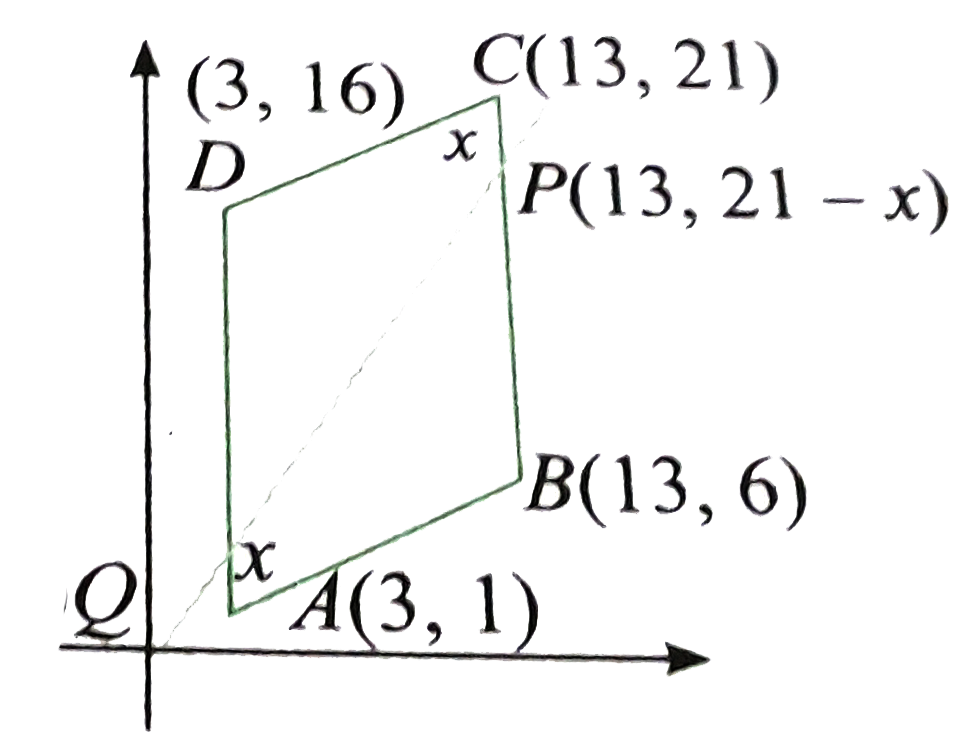The vertices of a parallelogram are and If a line passing through the origin divides the parallelogram into two congruent parts, then the slope of the line is Solution in Tamil
The correct Answer is:B
Slope of line thorugh origin is,
or
or
or
Hence,

Topper's Solved these Questions
- COORDINATE SYSYEM BOOK - CENGAGECHAPTER - COORDINATE SYSYEM EXERCISE - Exercise (Multiple)
13 Videos
- COORDINATE SYSYEM BOOK - CENGAGECHAPTER - COORDINATE SYSYEM EXERCISE - Exercise (Comprehension)
10 Videos
- COORDINATE SYSYEM BOOK - CENGAGECHAPTER - COORDINATE SYSYEM EXERCISE - Exercise 1.6
9 Videos
- COORDINATE SYSTEMBOOK - CENGAGECHAPTER - COORDINATE SYSTEMEXERCISE - Multiple Correct Answers Type
2 Videos
- CROSS PRODUCTS BOOK - CENGAGECHAPTER - CROSS PRODUCTS EXERCISE - DPP 2.2
13 Videos
Similar Questions
If (−6,−4),(3,5),(−2,1) are the vertices of a parallelogram, then the remaining vertex can be (0,−1) (b) 7,9) (−1,0) (d) (−11,−8)
View SolutionStudy the diagram. The line l is perpendicular to line m Does PE bisect CG?
View SolutionFind the locus of a point whose distance from (a, 0) is equal to its distance from the y-axis.
View SolutionCoordinates of points on curve 5x2−6xy+5y2−4=0 which are nearest to origin are
View SolutionLet →a and →b be two vectors of equal magnitude 5 units. Let →p,→q be vectors such that →p=→a−→b and →q=→a+→b. If |→p×→q|=2{λ−(→a.→b)2}12, then value of λ is
View SolutionA diagonal of a parallelogram divides it into two triangles of equal area. GIVEN : A parallelogram ABCD in which BD is one of the diagonals. TO PROVE : ar (ABD)=ar(CDB)
View SolutionThe vertices of a parallelogram ABCD are A(3,1),B(13,6),C(13,21), and D(3,16). If a line passing through the origin divides the parallelogram into two congruent parts, then the slope of the line is 1112 (b) 118 (c) 258 (d) 138
View SolutionThe diagonals of a parallelogram ABCD intersect at a point O. Through O, a line is drawn to intersect AD at P and BC at Q. Show that PQ divides the parallelogram into two parts of equal area.
View SolutionIn Fig. 21, ABCD is a parallelogram, DL⊥AB. If AB=20 cm , AD=13 cm and area of the parallelogram is 100 cm2 find AL.
View SolutionABCD is a parallelogram, and a,b,c and d are the position vector of vertices A,B,C and D of a parallelogram choose the correct option.
View SolutionA line through the origin divides parallelogram with vertices (10,45) , (10, 14) , (28,153) and (28,84) into two congruent pieces. The slope of the line is
View SolutionThe vertices of a parallelogram ABCD are A(3,1),B(13,6),C(13,21), and D(3,16). If a line passing through the origin divides the parallelogram into two congruent parts, then the slope of the line is (a) 1112 (b) 118 (c) 258 (d) 138
View SolutionABCD is a square A≡(1,2),B≡(3,−4). If line CD passes through (3,8), then the midpoint of CD is (a) (2, 6) (b) (6,2) (c) (2,5) (d) (285,15)
View SolutionThe vertices of a parallelogram ABCD are A(3,1),B(13,6),C(13,21), and D(3,16). If a line passing through the origin divides the parallelogram into two congruent parts, then the slope of the line is (a) 1112 (b) 118 (c) 258 (d) 138
View SolutionTwo circles passing through A(1,2),B(2,1) touch the line 4x+8y−7=0 at C and D such that ACED in a parallelogram. Then:
View SolutionIn a parallelogram ABCD diagonals AC and BD intersect at O and AC=6.8cm and BD=13.6cm. Find the measures of OC and OD.
View Solution
